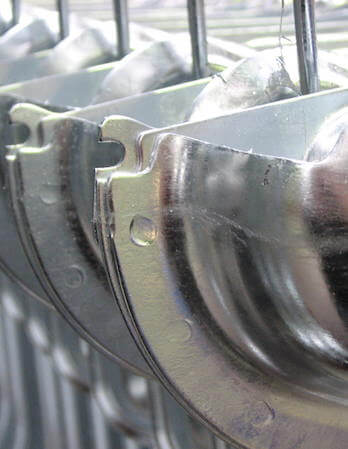
Hot dip galvanising
Hot dip galvanising
Electropoli, an international specialist in surface treatments, offers coatings using a "hot dip galvanising" process.
Parts are coated with a zinc layer through immersion in a molten zinc bath at 450° C.
This process improves the part in terms of corrosion, permeability and mechanical strength.
Like any deposition process, hot-dip galvanising is carried out in multiple stages:
1) Dry cleaning: This step removes all soils and grease that would prevent the dissolution of superficial iron oxides. It is carried out in baths containing strongly alkaline salts and products with added detergents and surfactants at a temperature between 60° C and 90° C.
2) The part is rinsed after dry cleaning to prevent cross-contamination in the following operations.
3) The part is stripped to remove scale and other oxides from the steel surface.
4) The part is rinsed again after the stripping to wash away the iron salts and traces of acid to prevent cross-contamination in the following operations.
5) The part is fluxed to prevent the steel from re-oxidising before entering the zinc bath. The decomposition of the flux also improves the iron/zinc metallurgical reaction when the part is immersed in the zinc bath. The fluxing is carried out at specific temperature with an aqueous solution of zinc chloride and ammonium chloride.
6) The part is then put in an oven to dry the flux, increase the temperature, avoid thermal shocks, & prevent zinc splashes when immersing the part.
7) Hot-dip galvanising: the parts are then immersed in the molten zinc bath at 450° C. The immersion time varies depending on the weight, dimensions, thickness, type, and shape of the part (and any specific requirements).
8) The galvanised parts are then cooled in the open air and checked. They may be put together and assembled with other components to form subsets that are directly usable by our customers.
The preparation of your parts before treatment
The preparation of the parts is the necessary phase before any application of treatments: it is the guarantee of the coatings adhesion on the treated parts.
This preparation can take many forms:
- - Mechanical
- - Chemicals
- - Thermal
- - Electrolytics - etc
The most frequently used techniques are :
- degreasing (with the aim of removing oils and greases present on the surface of the parts)
- pickling (with the aim of eliminating all the oxides present)
These 2 steps expose the material and make it suitable for coating.





